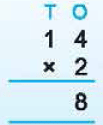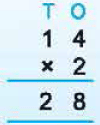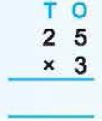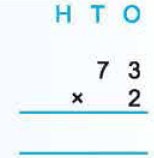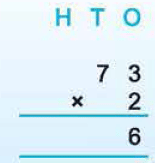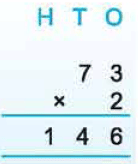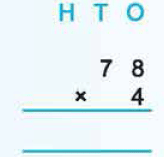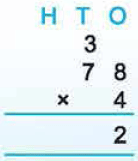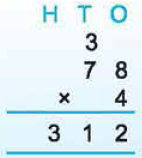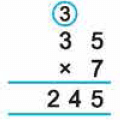Class 3 Maths - Multiplication - Question Answers
Question 1: Multiply 14 by 2.
Step 1: Arrange the numbers in columns.
Step 2: First multiply the ones digit by 2. 4 x 2 = 8. So, write 8 in the ones column.
Step 3: Next multiply the tens digits by 2. 1 x 2 = 2. So, we write 2 in the tens column.
Hence, 14 x 2 = 28
Question 2: Multiply 25 by 3.
Step 1: Write the numbers in columns.
Step 2: First multiply the ones digit by 3. 5 ones x 3 = 15 ones= 1 ten + 5 ones. So, we write 5 in the ones column and cany over 1 to the tens place.
Step 3: Next multiply the tens digit by 3. 2 tens x 3 = 6 tens. Add 1 ten (carried) to 6 tens. 6 tens + 1 ten = 7 tens. We write 7 in the tens column. So, 25 x 3 = 75
Hence, 25 x 3 = 75.
Question 3: Multiply 73 by 2.
Step 1: Write the numbers in columns.
Step 2: First multiply the ones digit by 2. 3 ones x 2 = 6 ones. So, we write 6 in the ones column.
Step 3: Next multiply the tens digit by 2. 7 tens x 2 = 14 tens = 1 hundred + 4 tens. So, we write 4 in the tens column and 1 below hundreds column.
So, 73 x 2 = 146.
Question 4: Multiply 78 by 4.
Step 1: Arrange the numbers in columns.
Step 2: First multiply the ones digit by 4. 8 ones x 4 = 32 ones = 3 tens + 2 ones. So, write 2 in the ones column and carry over 3 to tens column.
Step 3: Next multiply 7 tens by 4. 7 tens x 4 = 28 tens. Add 3 tens (carried) to 28 tens. 28 tens + 3 tens = 31 tens = 3 hundreds + 1 ten. So, write 1 below tens column and 3 below hundreds column.
So, 78 x 4 = 312.
Question 5: Estimate the sum 163 + 149 to the nearest hundred and verify its closeness to the actual sum.
Rounding off to nearest 100, we have
163 → 200 as 6 > 5 ⇒ 63 → 10 0 ⇒ 163 → 200
149 → 10 0 as 4 < 5 ⇒ 49 → 00 ⇒ 149 → 10 0
Thus, 163 + 149 → 200 + 100 = 300
Actual sum = 163 + 149 = 312.
Question 6: Estimate the difference 587 - 329 to the nearest 10 0, and also find the actual difference.
Rounding off to nearest 100, we have
587 → 600 as 8 > 5 ⇒ 87 → 10 0 or 587 → 600
and 329 → 300 as 2 < 5 ⇒ 29 → 00 or 329 → 300.
Thus, 587 - 329 → 600 - 300 = 300.
Actual difference = 587 - 329 = 258.
Question 7: Estimate the product of 33 and 18.
33 → 30 (rounding off to ten's place)
18 → 20 (rounding off to ten's place)
33 x 18 = 30 x 20 = 600.
Estimated product is 600.
Question 8: The cost of a chocolate is ₹ 12 Rohit bought 8 chocolates for his birthday party. How much did he spend on chocolates?
Cost of 1 chocolate = ₹ 12
Cost of 12 chocolates = ₹ 12 x 8 = ₹ 96
Hence, Rohit spent ₹ 96 on chocolates.
Question 9: A man sells 35 tickets every day. Find the number of tickets, he sells in 7 days.
In one day, the man sells 35 tickets.
In 7 days, he will sell 35 x 7 tickets.
Hence, the man sells 245 tickets in 7 days.
Question 10: Mary has 20 flower pots. She planted 32 seeds in each pot. How many seeds did she sow? Mention the value you depict from this.
In one pot, Mary planted 32 seeds.
In 20 pots, she will plant 32 × 20 seeds.Hence, Mary sowed 640 seeds in total.
|
18 videos|120 docs|25 tests
|
FAQs on Class 3 Maths - Multiplication - Question Answers
| 1. What is multiplication? |  |
| 2. How is multiplication taught in Class 3? |  |
| 3. How can I help my child practice multiplication at home? |  |
| 4. What are some common multiplication strategies taught in Class 3? |  |
| 5. How can I overcome my child's difficulties in learning multiplication? |  |


